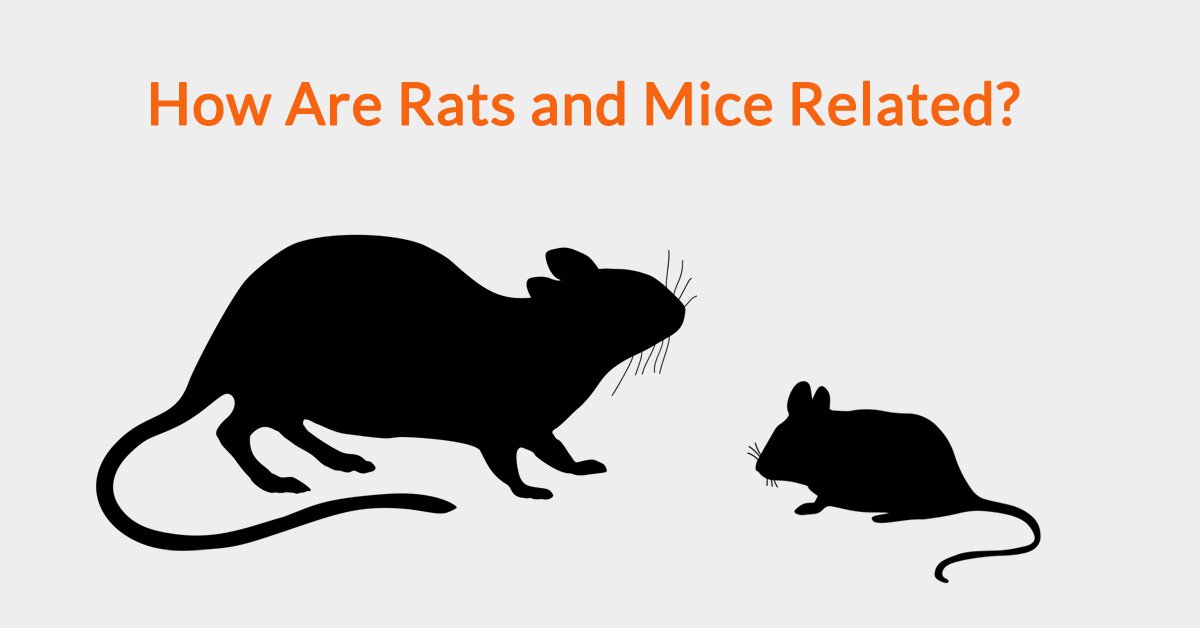
How Are Rats and Mice Related?

There's a lot of confusion about the similarities and differences between rats and mice. Most people simply judge the two species by size. If they see a long-tailed rodent that is small then they call it a mouse and if the rodent is large it's many people label it a rat. However, there's a lot more to the relationship between these Muroidea of the order of Rodentia. This raises the question of how mice and rats are related in the first place?
What Does the Term Rat and Mouse Mean to the Average Person?
Ask the average person to describe a mouse and they'll typically point out that it's a small rodent with a long, thin tail, whiskers and short fur. Ask them to describe a rat and they'll usually just say it's a larger version of a mouse with those same characteristics.
The main point to keep in mind is that the term rat and mouse isn't a scientific classification. Any discussion of rats and mice will typically involve casual definitions. This is why there's a lot of confusion about their specifics.
For example, there's a considerable amount of debate centered around how many types of rats and mice are in existence. This is largely because answering that question requires a firm definition of what a rat and mouse are in the first place. Different people usually draw a line between the two species in different ways, and this results in a wide variety of different definitions and classifications. Of course, science requires a firmer and more exact categorization. So we can get more answers about the similarities between the two rodents by seeing what biologists have to say.

What Does Science Have To Say?
The study of genetics has revolutionized how people look at different species. Sometimes it highlights the differences between species. And sometimes genetics shows how much two species have in common. There's a little of both when looking at rats and mice.
The main point of similarity comes from the two species' shared biological order. Both rats and mice are classified under the Rodentia order. Rats are usually further defined by their membership in the Rattus genus. While mice are usually defined by the fact that they're in the Mus genus. However, it's important to keep in mind that this only applies within strict biological science. For example, deer mice belong to the Peromyscus genus. And pack rats belong to the Neotoma genus.
The reason for the exceptions comes from the fact that most of the animals were classified before genetic testing had been invented. Researchers simply classified animals based on anatomical similarity to each other. When genetic testing came around the genus was named after the primary members of the group. Mus for mouse and Rattus for rat, but it soon became clear that a lot of rodents looked and behaved a lot like rats or mice but didn't actually belong to the same genus.
Going Over the Rodent’s Family Tree
On a genetic level, the mouse and rat should be considered more as cousins than siblings. They're both descended from a single ancestor species called anagalids (Anagale). The divergence happened so long ago that dinosaurs had only just become extinct at that point. In fact, it was the absence of dinosaurs and other large animals which gave mammals a chance to evolve and diverge in the first place. This led anagalids to diverge into three main lines. These genetic lines consist of mice, rats and rabbits. But if they diverged so long ago, why do they look so similar?
Similar Environments and Similar Behavior
The difficulty classifying these two types of rodents is obvious on looking at them without any preconceptions. A rat and mouse are typically only inches apart in size. They both have long, thin, tails. Both species have a similar range of coloration and texture to their fur. Even their ears look a lot alike.
On top of that, their environments and behaviors have a lot in common. Both mice and rats are predominantly nocturnal. Their small size and similar dietary preferences often put them into a similar environment, and both species tend to have an affinity with humans that keeps them in sight of civilization.
Rats and mice look alike and largely act alike. But how are these two animals so similar to each other when they're more genetic cousins than siblings? The answer has a lot to do with something known as convergent evolution.

Why Do Rats and Mice Have So Much in Common?
Animals tend to be heavily shaped by their environment. For example, consider all of the similarities between a dolphin and a shark. The two animals look quite similar in a lot of respects. But one's a mammal and the other's a fish. On a genetic level a human and a dolphin have more in common than a dolphin and a shark. But if you looked at a human, a dolphin, and a shark then humanity would clearly seem like the odd one out.
The similarity comes about in large part because the animals live within the same general environment. Over time animals in the same environment often come to acquire similar traits. It's due to the fact that these traits are a universal benefit to any animal within that space.
Now consider just how strong that effect would be with two species that are already related to each other. If a similar environment can shape a fish and mammal to look alike, then what could it do for two cousin species like rats and mice? It's estimated that rats and mice diverged about 33 million years ago. However, since that time they've been competing in very similar environments. And both species have been particularly shaped by humanity's environmental pressures. Both species also gain a lot from being able to escape the notice of humans while still enjoying the benefits of civilization. Thus, there's a strong selective pressure for nocturnal behavior.
Likewise, both species benefit from being able to enjoy most of the same foods as humans, and we can see that both species tend to have a similar affinity for human food. A hole in a cereal box could easily mean either a rat or mouse has taken up residence. Even an interest in sneaking into warm, secluded, environments helps both rats and mice wind up in the same place — your home.

Why These Similarities Are So Important
On a practical level these similarities impact your rat trap success, because for all their similarities, there are some significant differences between rats and mice. One of the most important when catching them relates to curiosity. Mice are extremely curious and willing to venture out into more dangerous areas than a rat. A rat is also far more likely to be tempted by meat than a mouse will.
Misidentification of rats and mice can lead to people working with the wrong tactics or food. A common reason for your rat trap not working is that you might not actually be trying to trap a rat. This is especially true when you notice food elimination in the trap but no sign that it took care of the intruding rodent. Rat trap success is also commonly dependent on the size of a rodent. A rat trap not working consistently while still showing signs of food elimination can often be due to misjudging whether you're dealing with a rat or mouse.
Identification issues are also why more advanced rat and mouse traps like the A24 are so highly recommended. The A24 can handle both rat and mouse problems equally well, and using it gets past the fact that these two species of rodents are often more similar than they are different. As such, you should always try to use these advanced traps when you notice any rodent that might be either a rat or a mouse. The right trap can take care of both equally well.
- Choosing a selection results in a full page refresh.
!

